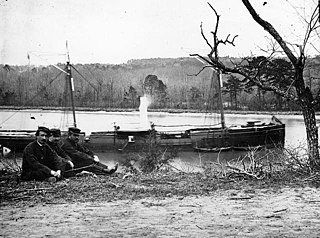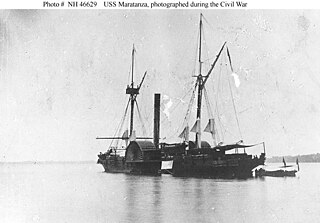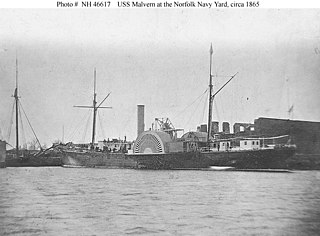
The first USS Sassacus, a wooden, double-ended, side-wheel steamer, was launched on 23 December 1862 by the Portsmouth Naval Shipyard in Kittery, Maine, sponsored by Miss Wilhelmina G. Lambert. Sassacus was commissioned at the Boston Navy Yard on 5 October 1863, Lieutenant Commander Francis A. Roe in command.

CSS Robert E. Lee was a fast paddle-steamer, originally built as a Glasgow-Belfast packet boat named Giraffe, which was bought as a blockade runner for the Confederate States during the American Civil War, then subsequently served in the United States Navy as USS Fort Donelson and in the Chilean Navy as Concepción.

USS Fort Jackson was a wooden sidewheel steamer in the United States Navy during the American Civil War. She was successful in enforcing the Union blockade of Confederate ports, capturing five ships carrying contraband. She participated in the battles for Fort Fisher, which effectively closed the port of Wilmington, North Carolina to the Confederacy. Most notably, the surrender of Confederate forces in Texas was signed aboard the ship, formally ending the Civil War in that portion of the country.

The first USS Monticello was a wooden screw-steamer in the Union Navy during the American Civil War. She was named for the home of Thomas Jefferson. She was briefly named Star in May 1861.

USS Kansas was a gunboat constructed for the Union Navy during the middle of the American Civil War. She was outfitted with heavy guns and assigned to the Union blockade of the waterways of the Confederate States of America. She was the first U.S. Navy ship to be named Kansas and was the first of a class of 836-ton screw steam gunboats. At war's end, she continued serving her country by performing survey work and defending American interests in Cuba until sold in 1883.

The first USS Mount Vernon was a wooden-screw steamer in the United States Navy.

The first USS Nansemond, a side wheel steamer built at Williamsburg, N.Y. in 1862, as James F. Freeborn, was purchased by the Union Navy at New York City on 18 August 1863 from Richard Squires; it was renamed Nansemond and commissioned at Baltimore on 19 August, with Lieutenant Roswell H. Lamson in command.

USS Aries was an 820-ton iron screw steamer built at Sunderland, England, during 1861–1862, intended for employment as a blockade runner during the American Civil War. She was captured by Union Navy forces during the Union blockade of the Confederate States of America, and was commissioned as a Union gunboat. Aries was named for the constellation.

USS Maratanza was a steamer acquired by the Union Navy during the American Civil War. She was used by the Union Navy as a gunboat to patrol navigable waterways of the Confederacy to prevent the South from trading with other countries.

USS Howquah was a screw steamer purchased by the Union Navy in Boston from G. W. Upton on 17 June 1863, for action against Confederate commerce raider CSS Tacony which was then preying upon Northern merchantmen during what Professor Richard S. West has called "the most brilliant daredevil cruise of the war."
The USS Governor Buckingham was a hermaphrodite brig in the United States Navy during the American Civil War. The ship was built under contract by Messrs Maxon Fish & Co., Mystic, Conn., and was offered for sale to the Navy while on the ways; purchased at Stonington, Connecticut, 29 July 1863 by Isaac Henderson for $110,000; delivered at New York Navy Yard 30 September 1863; and commissioned 13 November 1863, Acting Volunteer Lt. W. G. Saltonstall in command. She was assigned to the North Atlantic Blockading Squadron, with instructions to report at Hampton Roads to Acting Rear Admiral S. P. Lee. The ship was probably named for the Governor of Connecticut, William Alfred Buckingham.

The USS Cherokee was a 606-ton screw steam gunboat in the US Navy during the American Civil War ship. The ship later served in the Chilean Navy.

USS Malvern was a large steamer captured by the Union Navy during the American Civil War. She was then used by the Union Navy to patrol navigable waterways of the Confederacy to prevent the South from trading with other countries.
USS Berberry was a steam-powered tugboat acquired by the Union Navy during the American Civil War. She was used by the Navy to patrol navigable waterways of the Confederacy to prevent the South from trading with other countries.
USS Iron Age was a steamer acquired by the Union Navy during the American Civil War. She was used by the Navy to patrol navigable waterways of the Confederacy to prevent the Confederates from trading with other countries.
USS Tristram Shandy was a 444-ton steamer and blockade runner captured by the Union Navy during the American Civil War.

USS Columbia was a steamer captured by the Union Navy during the American Civil War. She was used by the Union Navy to patrol navigable waterways of the Confederacy to prevent the South from trading with other countries.
USS Britannia was a steamer captured by the Union Navy during the American Civil War. She was used by the Union Navy as a gunboat and patrol vessel in support of the Union Navy blockade of Confederate waterways.

USS Preston was a blockade-running steamer originally named Annie that was captured by the Union Navy during the American Civil War.
USS Shokokon was a large (709-ton) steamer with powerful 30-pounder rifled guns, purchased by the Union Navy during the beginning of the American Civil War.














